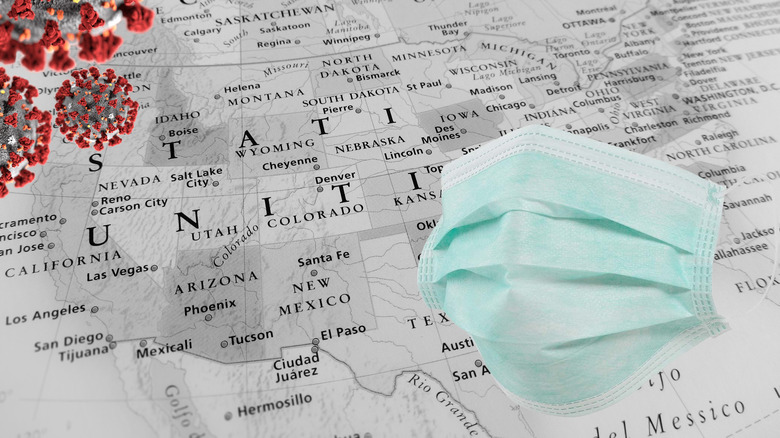How The U.S. COVID-19 Death Toll Is Now Higher Than The 1918 Pandemic
After more than a year and a half since the onset of the COVID-19 pandemic, the United States has reached another sad milestone. According to Johns Hopkins University, the U.S. has surpassed 676,000 deaths — or 1 in 500 Americans — due to COVID-19. This means COVID-19 deaths in the U.S. have now surpassed the estimated number of deaths that resulted from the pandemic of 1918 (via CDC). However, epidemiologist Stephen Kissler of the Harvard T. H. Chan School of Public Health pointed out to CNN that the U.S. population has tripled since 1918, and so our proportion of deaths is lower by comparison.
The U.S. currently leads the world in coronavirus deaths, followed by Brazil and India. Total coronavirus deaths across the world have exceeded 4.7 million. According to the Mayo Clinic, COVID-19 was first identified in 2019 and is believed to have originated in China. In March 2020 that the World Health Organization (WHO) officially identified the outbreak as a pandemic.
Not unlike the 1918 pandemic, the COVID-19 pandemic has continued, in part, due to ongoing waves and variants. According to the History Channel, the highest number of fatalities during the global pandemic of 1918 was during a "second wave" when the virus mutated into a more deadly strain "that had the power to kill a perfectly healthy young man or woman within 24 hours of showing the first signs of infection" and was transferred through the movements of World War I troops.
Why COVID-19 cases are rising
A September 17 report from the Centers for Disease Control and Prevention shows that COVID-19 cases are on the rise in the United States. The prior seven-day average of COVID-19 cases was 137,783; the current seven-day average is 146,182. This is an increase of 6.1%. The CDC reports that this increase is likely due to "the highly contagious Delta (B.1.617.2) variant and low vaccination coverage in many communities." As of this reporting, roughly 54% of Americans have been fully vaccinated.
Although there are similar patterns to the spread of disease and response since as far back as the Black Death of 1347, "the major risks posed by COVID-19 arise not from the pathogen, but from indirect effects of control measures on health and core societal activities," according to an April 2021 study published in the Frontiers in Public Health. The prevalence of COVID-19 may also be a result of an erosion of public trust that originated with the 1918 Pandemic.
In a February 2021 study titled "Epidemics and trust: The case of the Spanish Flu," researchers concluded that "experiencing the Spanish Flu and the associated condition of social disruption and generalized mistrust had permanent consequences on individual behavior in terms of lower social trust." They continued, writing, "These mutated individual social traits were inherited by descendants, at least to some significant degree." Epidemiologist Stephen Kissler told CNN, "A lot of the mistakes that we definitely fell into in 1918, we hoped we wouldn't fall into in 2020. We did."


